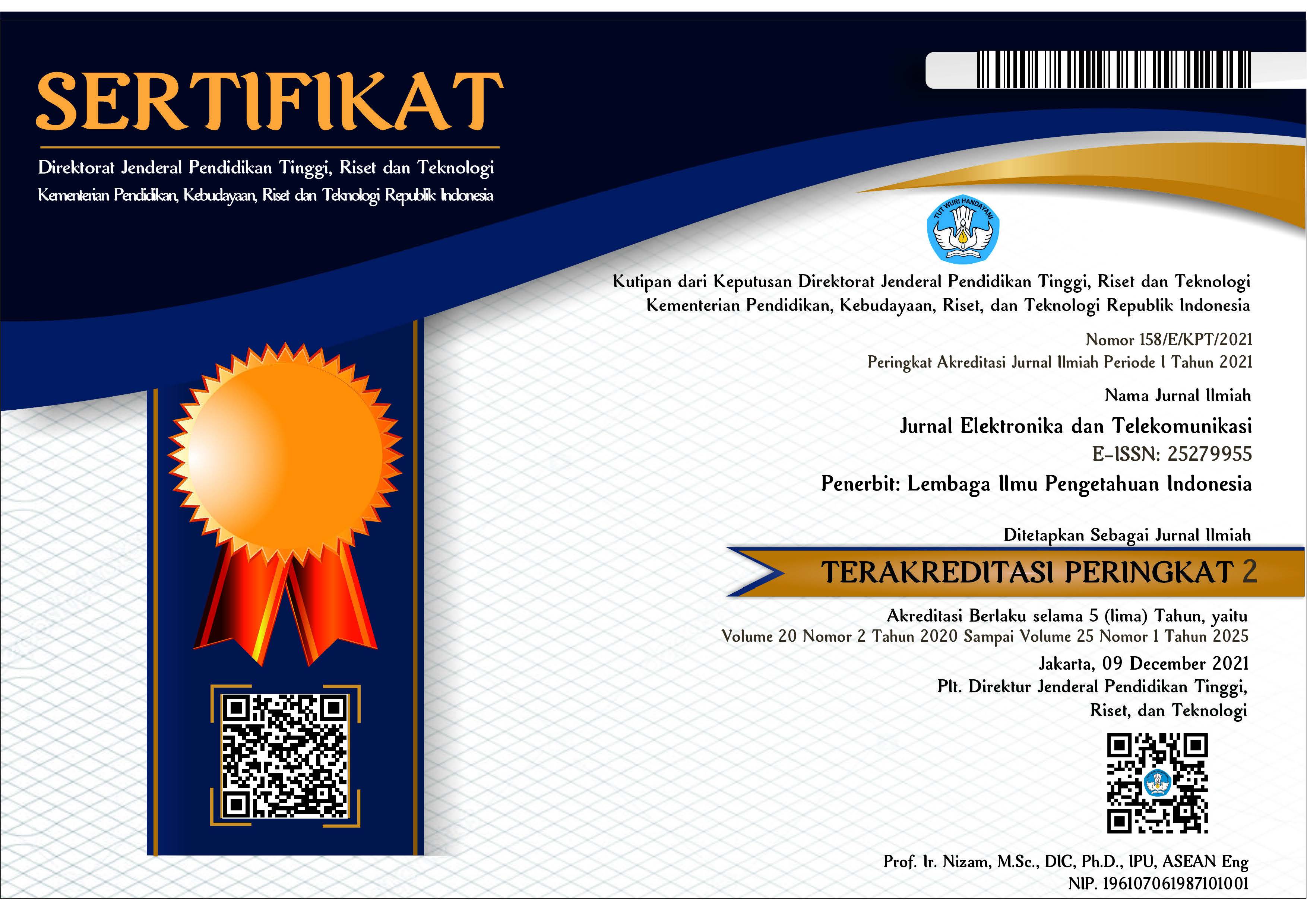Power Regulator Design Using LM317 for Precise and Efficient Power Management
Abstract
The Indonesian government plans to transition its transportation sector to electric vehicles (EVs) by 2025. Achieving this ambitious target will necessitate advancements in power management technologies. Therefore, the government is boosting research on energy efficiency, cutting power dissipation, and enhancing the reliability and lifespan of EV components. This study focuses on designing a power-efficient linear voltage regulator using the LM317, which is essential for EV power management. The regulator employs a voltage comparator to monitor feedback voltage and select the correct input voltage, ensuring efficient and stable output power. We tested the LM317 against the LM338 and LM350 in various setups. The results showed that the LM317 performed better in terms of voltage precision, efficiency, power dissipation, and temperature stability. Moreover, the LM317 achieved 75% efficiency in single-source setups and 85% in multi-source configurations, with a voltage precision of ±0.1%. The system’s ability to dynamically select input sources ensures optimal performance for small-signal EV applications.
Keywords
References
D. F. Hakam and S. Jumayla, “Electric vehicle adoption in indonesia: lesson learned from developed and developing countries,” Sustainable Futures, vol. 8, p. 100348, Dec. 2024, doi: 10.1016/J.SFTR.2024.100348.
N. Dayanand Lal, S. Ramanjaneyulu Korada, S. Avv, V. B. Reddy Muvva, and S. Sharath Shankar, “Optimizing energy efficiency in electric vehicles: intelligent control system design,” 2023 International Conference on Evolutionary Algorithms and Soft Computing Techniques, EASCT 2023, 2023, doi: 10.1109/EASCT59475.2023.10393359.
R. W. Erickson and D. Maksimović, “Fundamentals of power electronics,” Fundamentals of Power Electronics, 2020, doi: 10.1007/978-3-030-43881-4.
M. Rashid, “Power electronics: circuits, devices & applications 4th edition,” Pearson. Pearson, Jul. 2013. Accessed: Nov. 01, 2024. [Online]. Available: https://www.academia.edu/38989807/Power_Electronics_Circuits_Devices_and_Applications_By_Muhammad_H_Rashid
J. Xue, X. Q. Zhang, X. Liu, and S. P. Li, “Design considerations of step-down switching converters,” Procedia Eng, vol. 24, pp. 100–105, Jan. 2011, doi: 10.1016/J.PROENG.2011.11.2609.
Sanjaya. Maniktala, “Switching power supply design & optimization,” McGraw Hill Professional, p. 395, 2005, Accessed: Nov. 02, 2024. [Online]. Available: https://books.google.com/books/about/Switching_Power_Supply_Design_Optimizati.html?id=3Li_Aq-UXlgC
H. W. Ott, “Noise reduction in electronic systems,” John Willey and Sons, 1988.
Texas Instrument, “LM150/lm350a/lm350 3-amp adjustable regulators,” 1998. [Online]. Available: www.ti.com
Texas Instrument, “LM318 and lm388 5-amp adjustable regulators,” Texas Instrument Datasheet, 2016.
J. A. Villanueva-Loredo, M. G. Ortiz-Lopez, J. Leyva-Ramos, and L. H. Diaz-Saldierna, “Switching regulator based on a non-inverting step-down/up dc–dc converter for lithium-ion battery applications,” Micromachines 2023, Vol. 14, Page 1144, vol. 14, no. 6, p. 1144, May 2023, doi: 10.3390/MI14061144.
S. Köse and E. G. Friedman, “An area efficient fully monolithic hybrid voltage regulator,” ISCAS 2010 - 2010 IEEE International Symposium on Circuits and Systems: Nano-Bio Circuit Fabrics and Systems, pp. 2718–2721, 2010, doi: 10.1109/ISCAS.2010.5537035.
X. Zhang, T. Wang, H. Bao, Y. Hu, and B. Bao, “Stability effect of load converter on source converter in a cascaded buck converter,” IEEE Trans Power Electron, vol. 38, no. 1, pp. 604–618, Jan. 2023, doi: 10.1109/TPEL.2022.3199234.
K. K. Leong, G. Deboy, K. Krischan, and A. Muetze, “A single stage 54v to 1.8v multi-phase cascaded buck voltage regulator module,” Conference Proceedings - IEEE Applied Power Electronics Conference and Exposition - APEC, vol. 2015-May, no. May, pp. 1966–1973, May 2015, doi: 10.1109/APEC.2015.7104617.
Y. Bai, V. W. Lee, and E. Ipek, “Voltage regulator efficiency aware power management,” ACM SIGPLAN Notices, vol. 52, no. 4, pp. 825–838, Apr. 2017, doi: 10.1145/3037697.3037717.
F. Chen, R. Burgos, D. Boroyevich, J. C. Vasquez, and J. M. Guerrero, “Investigation of nonlinear droop control in dc power distribution systems: load sharing, voltage regulation, efficiency, and stability,” IEEE Trans Power Electron, vol. 34, no. 10, pp. 9407–9421, Oct. 2019, doi: 10.1109/TPEL.2019.2893686.
S. Hasanpour, Y. P. Siwakoti, and F. Blaabjerg, “A new high efficiency high step-up dc/dc converter for renewable energy applications,” IEEE Transactions on Industrial Electronics, vol. 70, no. 2, pp. 1489–1500, Feb. 2023, doi: 10.1109/TIE.2022.3161798.
L. F. Lai et al., “Design trends and perspectives of digital low dropout voltage regulators for low voltage mobile applications: a review,” IEEE Access, vol. 11, pp. 85237–85258, 2023, doi: 10.1109/ACCESS.2023.3303809.
texas instrument, “LM317 3-terminal adjustable regulator battery-charger circuit,” 1997. [Online]. Available: www.ti.com
A. Rahali, K. El Khadiri, H. Qjidaa, and A. Tahiri, “Switching regulator based on an adaptive dc-dc buck converter for a lithium-ion battery charging interface,” IAES International Journal of Robotics and Automation (IJRA), vol. 13, no. 3, pp. 351–360, Sep. 2024, doi: 10.11591/IJRA.V13I3.PP351-360.
C. I. Cahyadi, I. Gusti, A. Ayu, M. Oka, and D. Kusyadi, “Efisiensi recharger baterai pada pembangkit listrik tenaga surya,” Edu Elektrika Journal, vol. 9, no. 2, pp. 61–65, Dec. 2020, doi: 10.15294/EEJ.V9I2.42855.
R. W. Erickson and D. Maksimović, “Fundamentals of power electronics,” Fundamentals of Power Electronics, 2020, doi: 10.1007/978-3-030-43881-4.
B. Banerjee, D. Jayaweera, and S. Islam, “Smart power systems and renewable energy system integration,” Studies in Systems, Decision and Control, vol. 57, pp. 1–13, 2016, doi: 10.1007/978-3-319-30427-4_1.
J. Xue, X. Q. Zhang, X. Liu, and S. P. Li, “Design considerations of step-down switching converters,” in Procedia Eng, 2011, vol. 24, pp. 100–105. doi: 10.1016/j.proeng.2011.11.2609.
A. I. Pressman, K. Billings, T. Morey, F. Lisbon, and S. Juan, Switching Power Supply Design. McGraw-Hill Education, 2009. Accessed: Nov. 02, 2024. [Online]. Available: https://www.accessengineeringlibrary.com/content/book/9780071482721
B. K. Jones, “Electrical noise as a measure of quality and reliability in electronic devices,” Advances in Electronics and Electron Physics, vol. 87, no. C, pp. 201–257, Jan. 1993, doi: 10.1016/S0065-2539(08)60017-7.
M. H. Rashid, “Power electronics handbook, fourth edition,” Power Electronics Handbook, Fourth Edition, pp. 1–1496, Jan. 2017, doi: 10.1016/C2016-0-00847-1.
A. K. Singh and B. C. Pal, “Power system modeling, simulation, and control design,” Dynamic Estimation and Control of Power Systems, pp. 9–33, Jan. 2019, doi: 10.1016/B978-0-12-814005-5.00013-3.
Y. Yang, H. Wang, A. Sangwongwanich, and F. Blaabjerg, “Design for reliability of power electronic systems,” Power Electronics Handbook, Fourth Edition, pp. 1423–1440, Jan. 2018, doi: 10.1016/B978-0-12-811407-0.00051-9.
“Thermal management of electronic systems,” Thermal Management of Electronic Systems, 1994, doi: 10.1007/978-94-011-1082-2.
I. P.-Vaisband, R. Jakushokas, M. Popovich, A. V. Mezhiba, S. Köse, and E. G. Friedman, “Hybrid voltage regulator,” On-Chip Power Delivery and Management, pp. 277–292, 2016, doi: 10.1007/978-3-319-29395-0_17.
Y. Wang and T. Zhao, “A hybrid voltage regulator with arcless tap change and stepless voltage regulation functions,” ECCE 2020 - IEEE Energy Conversion Congress and Exposition, pp. 4857–4863, Oct. 2020, doi: 10.1109/ECCE44975.2020.9235339.
J. W. Liu, S. S. Choi, and S. Chen, “Design of step dynamic voltage regulator for power quality enhancement,” IEEE Transactions on Power Delivery, vol. 18, no. 4, pp. 1403–1409, Oct. 2003, doi: 10.1109/TPWRD.2003.817731.
J. Williams, “High efficiency linear regulators,” Analog Circuit Design Volume 2: Immersion in the Black Art of Analog Design, pp. 137–148, Dec. 2012, doi: 10.1016/B978-0-12-397888-2.00006-7.
P. Prabhakaran, Y. Goyal, and V. Agarwal, “Novel nonlinear droop control techniques to overcome the load sharing and voltage regulation issues in dc microgrid,” IEEE Trans Power Electron, vol. 33, no. 5, pp. 4477–4487, May 2018, doi: 10.1109/TPEL.2017.2723045.
S. Hasanpour, Y. P. Siwakoti, A. Mostaan, and F. Blaabjerg, “New semiquadratic high step-up dc/dc converter for renewable energy applications,” IEEE Trans Power Electron, vol. 36, no. 1, pp. 433–446, Jan. 2021, doi: 10.1109/TPEL.2020.2999402.
M. A. S. Bhuiyan et al., “CMOS low-dropout voltage regulator design trends: an overview,” Electronics 2022, Vol. 11, Page 193, vol. 11, no. 2, p. 193, Jan. 2022, doi: 10.3390/ELECTRONICS11020193.
Article Metrics
Metrics powered by PLOS ALM
Refbacks
- There are currently no refbacks.
Copyright (c) 2024 National Research and Innovation Agency

This work is licensed under a Creative Commons Attribution-NonCommercial-ShareAlike 4.0 International License.























